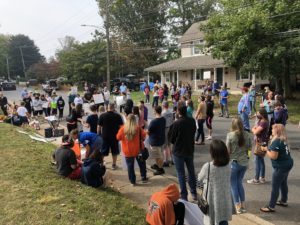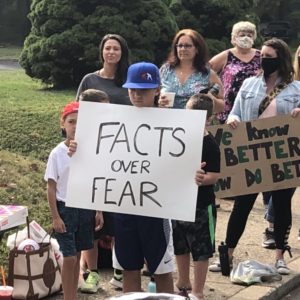Parents and students gathered outside the Pennsbury School District Administration building in Bucks County on Friday to protest the district’s distance learning plan.
About 75 community members attended the event, where speakers asked the school board to immediately re-open schools for in-person learning, or if not, provide metrics to determine when it is safe for students to return to their school buildings.
The protesters stood on the sidewalk with signs that read “Restaurants reopened, why can’t schools?” and “‘Wait and see’ is not a plan!”
The event originated from a Facebook group called ReOpen Pennsbury Schools, which gained 1,200 members in five days after local parent Diana Donnelly started it last week.
“It started the day of the last school board meeting, last Thursday,” Donnelly said. “They’d sent out a Google form where you could submit a question or statement for the school board meeting, so I created the group to get people together to submit for that. They had more than a hundred comments, and the school board president – he kind of just read over them and never answered anything. After nothing was accomplished from the meeting, another mom said we should have a rally.”
Community members like Donnelly say they are concerned about the impact that virtual learning is having on students, saying that it is a frustrating experience and children are falling behind academically.
The School Board voted unanimously to keep learning virtual-only through January 29, 2021 at a meeting on August 20, after initially approving a hybrid plan a month earlier. While the July school board meeting also approved in-person instruction for students with Individualized Education Plans (IEPs) or Section 504 Plans under the Americans with Disabilities Act, parents say that there is no longer any support for students with specialized learning needs and any in-person options have been scrapped.
Jane O’Neill, a parent in the district, has a son in the 5th grade with an IEP – she says that the resources that create an appropriate learning environment for her son have evaporated.
“Initially a few weeks ago, they had been speaking about making special exemptions for students with IEPs and 504s, so they could receive their legal services as per the IEP,” O’Neill said. “And all of a sudden, the tone changed, and the next board meeting, it was just a blanket statement across the board that all children would be virtual learning regardless.”
O’Neill said that her family’s experience with virtual learning has been disastrous.
“I now have a child who tells me he has no reason to get out of bed and he has nothing to live for. He’s regressing emotionally,” O’Neill told Delaware Valley Journal. “We are having one to two meltdowns every day in school. He can’t complete a full day of school because he has to walk away. None of the services in the positive support plan are being enacted at this point, because he needs to be in school for those things to happen.”
O’Neill, who runs her family business, said that her ability to work has been significantly impacted by virtual learning. “I work from 7 am to 3:30 pm; I can’t take time off to teach my son. He needs a one-to-one [para-professional]; he needs someone to sit next to him and physically re-teach these lessons, and I’m unable to do that. Right now I have him set up with a desk in my business office, so now I come home and catch up on work until 8 pm or 10 pm at night, and so the home structure we have in place to maintain some normalcy has been completely disrupted,” O’Neill said.
O’Neill is not alone; many parents speaking at the event said that virtual learning was impacting their family’s ability to work. Several parents said they were considering switching their child’s school, or homeschooling.
“I know some people who are spending eight hundred, nine hundred dollars a month to send their kids to daycare to do virtual school, because parents have to work!” said Donnelly. “It’s a lot of money; what about people who can’t afford that?”
The CDC has issued a risk assessment scale for reopening schools that takes into account the rate of new local COVID-19 cases over a 14-day period, as well as mitigation strategies like masks, social distancing, and frequent disinfection. The Pennsbury School Board has not clarified whether or not these metrics will be used to determine when it’s safe to go back to school.
The Pennsbury School Board has since responded to community input and promised to reevaluate in-person learning

